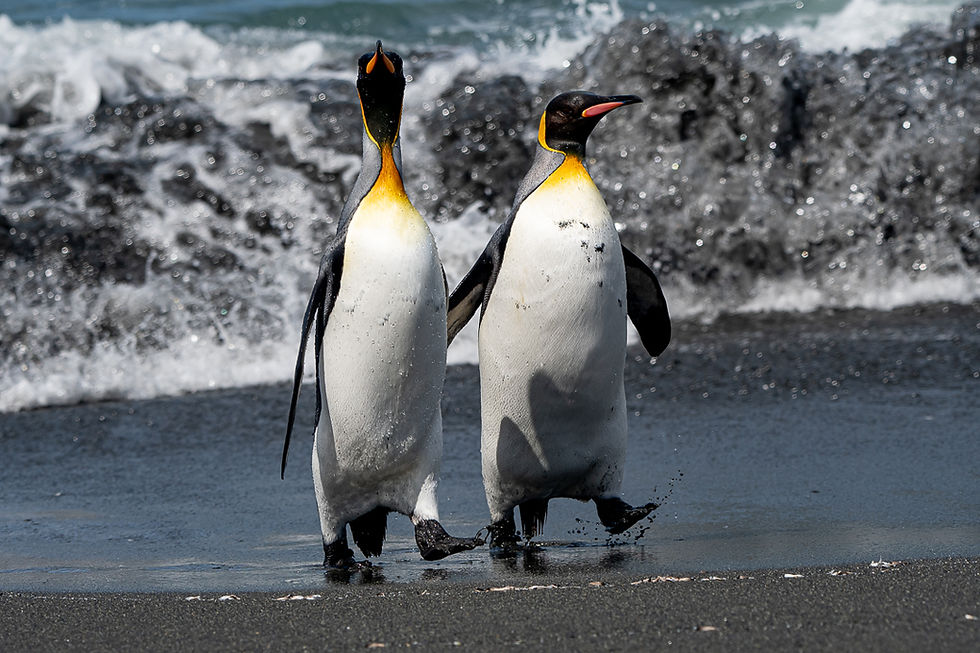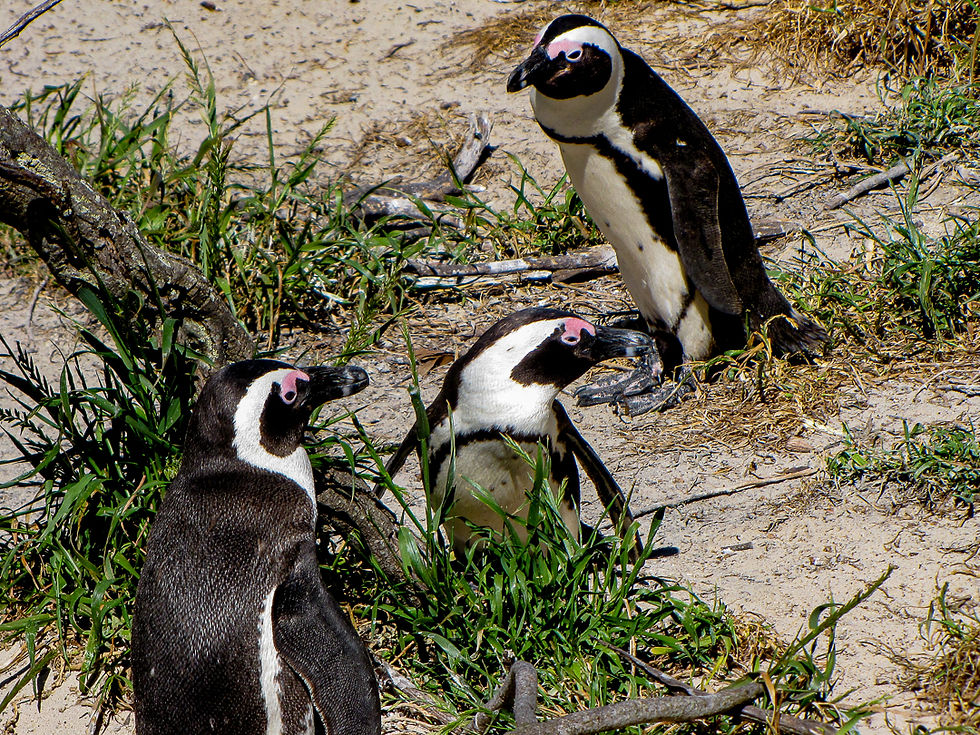Happy feet - Penguin extravaganza
- Tristan

- Sep 6, 2020
- 6 min read
Updated: Sep 11, 2020

Isn’t it fair to say, certain type of animals just make you smile? It’s no wonder the film franchise “Happy Feet” was such a success, who doesn’t love watching a penguin? Whereas in the northern hemisphere evolution left the auks and murres with the ability to fly, the penguins lost the power of flight millions of years ago. One can only guess why? Maybe due to the lack of predators or maybe there was more onus on walking than flying compared to their northern cousins or a combination of both? Whatever the reason, the waddle of a penguin is a joy to watch.
Over the years I’ve been lucky enough to catch up with ten of the world’s eighteen species in the wild so hope you enjoy the following photographic collection.
Galápagos penguins
I actually told a little fib in my opening generalisation, some of the Galápagos penguins live on the islands just north of the equator which the Galápagos archipelago straddles. Susceptible to El Niño events which affect the temperatures of the ocean, their numbers can fluctuate widely. Endemic to the islands and one of the world’s smallest penguin breeds, numbers are estimated at 2,000 birds. I was lucky to catch up with a small colony off Santiago and Bartolome. This included the amazing experience of snorkelling with a group and seeing them underwater.

Humboldt penguins
Another of the so-called “Banded” group of penguins is found along the west coast of South America, relying on the welling of the Humboldt Current to create rich feeding conditions. Many of the Humboldt penguins burrow into the guano (bird poop) to make their nests which is why I caught up with these fellows on the Ballestas Islands off Peru. A guano rich environment thanks to the boobies which breed here on mass. It's estimated the species has a population of just 30,000.


African penguins
Also known as the Cape penguin, one of the most well-known places to catch up with these is at Boulders Beach in South Africa although due to their nearness to human populations, the numbers have suffered from past exploitation, oil spills and competition from commercial fishing. With a population of 1.5 million estimated in 1915, just 20,850 pairs were recorded in Namibia and South Africa in 2019.
At Boulder’s beach, everyone walks the boardwalk to see the colony resting by the sea and the nesting birds who have made scrapes in the sand. Although a trail into the tussocks area may give you a more personal close up view with patience. Late afternoon is a good time to catch up with the colony as adults return from their daily fishing trip hunting fish and squid. You tend to feel sorry for the chicks trying to keep cool.



Magellanic penguins
Moving further south, the penguins named after the Portuguese explorer Ferdinand Magellan can be found living around the southern tip of South America and the Falklands Islands. Mating for life, they tend to come back to the colony of their birth spending the winter further north off Peru and Brazil. As with all the species mentioned so far, the life span can be up to 25 years. I would catch up with these guys on Saunders Island (part of the Falkland archipelago) as they moved to and fro from their burrows in the sand dunes to the sea.


Gentoo penguins
Moving on from the “Banded” penguins, we next come to the Brush-tailed which the scientists tell us split from the other penguins 38 million years ago, you have to love science and these incomprehensible numbers!
It’s not certain how the Gentoo got its name, there are several theories and can weigh in at 8 kg before the moult. Said to be the fastest swimmers of all penguins, they also tend to dive deeper so have less completion for food. It’s been estimated around 70 feathers cover each square inch so allowing their body temperature to remain constant.


Two eggs are laid with a 3-day gap with the second egg smaller in size. They are also one of the few species to lay a second clutch if the first fails. Nesting in close-knit colonies making scrapes for nests encircled with small stones, it’s fun to watch their antics as they steal stones from each other’s nests.

I was amazed in South Georgia to see one colony at least a mile inland, a lengthy walk or should I say waddle for a penguin. Maybe it’s to get away from the Giant petrels which patrol the nearby seal colony? With a population of over 600,000 the pressures are not as great as the Banded penguins but are declining in general.


It was also fun watching them moving up and down the "penguin highways" back and forth to the sea.

Chinstrap penguin
The next Brush-tailed penguin is the Chinstrap with an estimated population of eight million so making them possibly the most populous species. Breeding mainly on the islands of the South Atlantic and Antarctic seas so avoiding the pack ice, they feed predominately on krill. They are also a favoured prey for the alpha predator of the region, the Leopard seal.



Adélie penguin
The last of the Brush-tails is the Adélie, this time named after the French explorer Adélie Dumont d’Urvill which breed along the Antarctic coastline preferring colder climes, so have a more southerly distribution than most. My only sighting would be on the South Orkney Islands on the very northerly limit of their range.

It’s been estimated a colony of 5 million Adélie consumes 8 million kg of krill and small fish a day. That’s a staggering number if you scale up the numbers and take in all the penguins, seals and whales which feed in this region.
If parents have two chicks, once they get bigger the adults will run around the colony so pursued by the hungry chicks which can look very comical. It’s not known for sure why they do this, maybe to enforce exercise, possibly to see if there is one chick stronger than the other or possibly so they can distribute the food more evenly. Whatever the reason, I can’t help think it could have been the inspiration for some of the Hollywood film sequences.

Rockhopper penguin
We next come to the “Crested” penguins with several species living around the New Zealand region although for me, the first encounter would be the Southern Rockhoppers living amongst a Black-browed Albatross colony in the Falklands. Jumping amongst the boulders they certainly lived up to their name being quite a treacherous trek down to the sea.


It’s thought the Falklands population of 280,000 pairs is just 10% of its former size, possibly due to overfishing as the South American population was unaffected. The chicks are seriously cute and often join a “crèche” (group) for protection.

Macaroni penguin
Named by the English sailors because of their orange plume feathers which reminded them of the macaroni fashion back in Britain in the 18th century. This species tends to hop rather than waddle with the males being quite aggressive towards each other.

Eating krill they have been recorded diving to depths of 100 metres. Oddly the first smaller laid egg is often lost before the second larger egg is laid, a strange quirk of nature which no one can really understand?

King Penguin
The second largest of the penguin species standing up to a metre tall, their vast colonies are one of nature’s greatest spectacles. The yellow-orange colouring of the bill and upper body is striking while their weight falls between 10-18 KGs. There is no mistaking the King penguin if visiting the Island of South Georgia.


The chicks go through a 14-16 month cycle before being fully-fledged meaning while adults sit on their eggs, the chicks from the previous season are still going through their final moult and can be seen on the outer edges of the vast colonies.

My adventures would take me to Salisbury Plain on the Island of South Georgia where we would spend a couple of hours watching 60,000 penguins sat on eggs which were due to hatch at any time. The constant trumpeting calls with the heads pointing to the sky will always be a lasting memory.

Smaller groups of non-breeding adults can be found away from the colony undergoing moults.

So there you go, lots of penguins, not that you can ever see too many penguins! Maybe one day I will have the chance of catching up with more species in the oceanic region but doubt will ever see the holy grail of the penguin species, the Emperor. Suspect most of us have seen the documentaries so know this is the pleasure of the very few who have the time and money to trek to the most inhospitable landscapes on earth to observe…



Comments